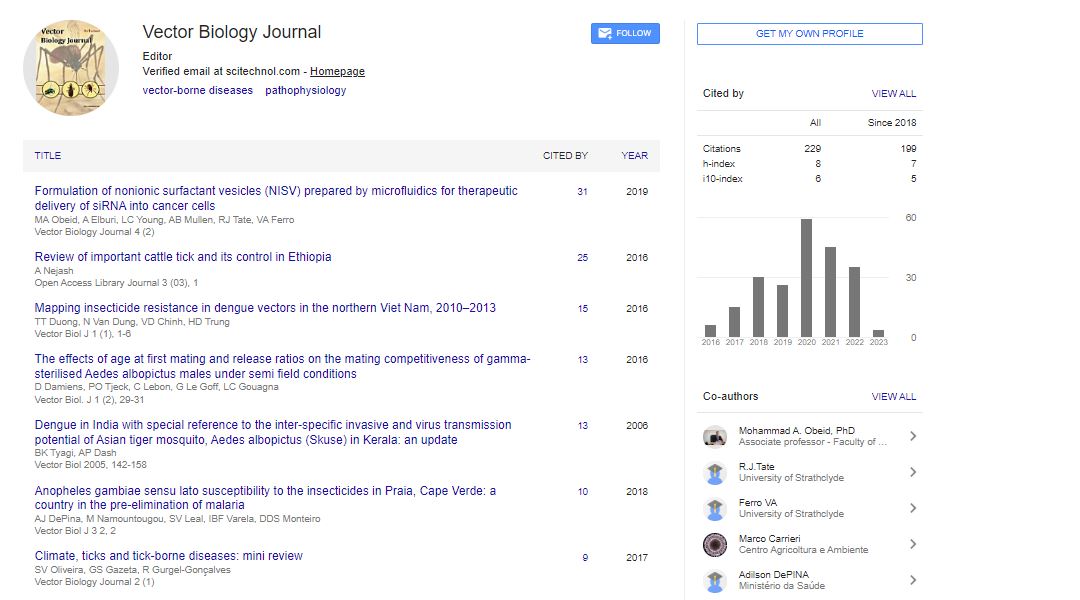Commentary, Vector Biol J Vol: 10 Issue: 1
Environmental and Biological Drivers of Tick-Borne Pathogen Transmission
Qiang Chen*
Department of Biology, Institute of Infectious Diseases, China
- *Corresponding Author:
- Qiang Chen
Department of Biology, Institute of Infectious Diseases, China
E-mail: chen.qia@gmail.com
Received: 01-Mar-2025, Manuscript No. VBJ-22-169493, Editor assigned: 03-Mar-2025, PreQC No. VBJ-22-169493(PQ), Reviewed: 17-Mar-2025, QC No. VBJ-22-169493, Revised: 21-Mar-2025, Manuscript No. VBJ-22- 169493(R), Published: 28-Mar-2025, DOI: 10.4172/2473-4810.1000336
Citation: Qiang C (2025) Environmental and Biological Drivers of Tick-Borne Pathogen Transmission. Vector Biol J 10: 336
Copyright: © 2025 Qiang C. This is an open-access article distributed under the terms of the Creative Commons Attribution License, which permits unrestricted use, distribution and reproduction in any medium, provided the original author and source are credited.
Abstract
Ticks are arthropods belonging to the order Ixodida and are
second only to mosquitoes in terms of their importance as vectors
of human and animal diseases. They transmit a wide variety of
pathogens, including bacteria, viruses, and protozoa, many of which
are zoonotic. Lyme disease, caused by Borrelia burgdorferi, is the most
reported vector-borne disease in North America.
Keywords: Tick-borne diseases, Vector ecology, Pathogen transmission dynamics, Environmental change, Climate variability
Introduction
Ticks are arthropods belonging to the order Ixodida and are second only to mosquitoes in terms of their importance as vectors of human and animal diseases. They transmit a wide variety of pathogens, including bacteria, viruses, and protozoa, many of which are zoonotic. Lyme disease, caused by Borrelia burgdorferi, is the most reported vector-borne disease in North America [1]. Understanding the ecology of ticks and the mechanisms of pathogen transmission is crucial to developing effective control and prevention strategies, especially as tick populations expand due to climate change and habitat modifications.
Description
Tick-borne pathogens are transmitted during the tickâ??s blood meal, which can last from several hours to days. The prolonged attachment to the host provides ample opportunity for the exchange of pathogens. Ticks undergo three developmental stagesâ??larva, nymph, and adultâ??and require a blood meal at each stage. This complex lifecycle often involves multiple host species, enhancing the potential for zoonotic transmission [2].
Ixodes scapularis (black-legged tick) and Ixodes ricinus are the primary vectors of Lyme disease in North America and Europe, respectively. These ticks are also competent vectors for Anaplasma phagocytophilum (causing human granulocytic anaplasmosis) and Babesia microti (causing babesiosis). The efficiency of transmission depends on factors such as host density, tick abundance, environmental conditions, and the presence of reservoir hosts like white-footed mice [3].
Ticks detect hosts through sensory structures sensitive to carbon dioxide, heat, and movement. They typically wait for a passing host on vegetation in a behavior known as questing. Environmental changes such as reforestation, increased deer populations, and suburban development have facilitated tick expansion and increased human exposure [4].
Discussion
Effective tick management requires an integrated approach combining surveillance, chemical control, biological agents, and public education. Acaricides remain the most common control method but are associated with environmental concerns and the risk of resistance development. Alternative strategies include deploying entomopathogenic fungi and nematodes, as well as leveraging predators such as birds and rodents that feed on ticks [5].
Host-targeted approaches, including deer exclusion and rodent bait boxes treated with acaricides, show promise in reducing tick populations. Landscape management, such as clearing brush and applying barriers like wood chips, helps reduce suitable tick habitats in residential areas. Community-based interventions and public awareness campaigns are vital for promoting preventive behaviors such as wearing protective clothing and using tick repellents.
Climate change plays a significant role in shifting the geographical distribution of ticks. Warmer temperatures and milder winters enable ticks to survive and reproduce in previously unsuitable regions. This shift increases the risk of tick-borne diseases in new areas, necessitating proactive surveillance and healthcare preparedness [3].
Conclusion
Ticks are highly effective vectors due to their prolonged feeding behavior and broad host range. Their expanding distribution poses a growing public health challenge. An ecological understanding of tick lifecycles, host interactions, and environmental influences is essential for effective control. Integrated pest management strategies, climate-responsive surveillance, and public engagement are key to reducing the burden of tick-borne diseases.
References
- Stephansson O, Falconer H, Ludvigsson JF (2011) Risk of endometriosis in 11, 000 women with celiac disease. Hum Reprod26: 2896-2901.
- Selam B, Kayisli UA, Garcia-Velasco JA, Arici A (2002) Extracellular matrix-dependent regulation of Fas ligand expression in human endometrial stromal cells. Biol Reprod66: 1-5.
- Sampson JA (1927) Peritoneal endometriosis due to the menstrual dissemination of endometrial tissue into the peritoneal cavity. Am J Obstet Gynecol14: 422-469.
- Poppe K, Velkeniers B (2003) Thyroid disorders in infertile women. Ann Endocrinol64: 45-50.
- May KE, Conduit-Hulbert SA, Villar J, Kirtley S, Kennedy SH, et al. (2010) Peripheral biomarkers of endometriosis: a systematic review. Hum Reprod Update16: 651â??674.
Indexed at, Google Scholar, Crossref
Indexed at, Google Scholar, Crossref
 Spanish
Spanish  Chinese
Chinese  Russian
Russian  German
German  French
French  Japanese
Japanese  Portuguese
Portuguese  Hindi
Hindi 